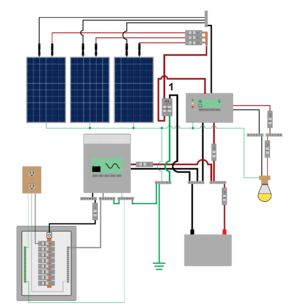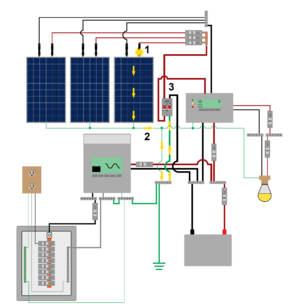Ground fault protection device
A ground fault protection device (GFPD) uses a low current breaker (.5-1 A) to create a connection between a conductor (wire) and ground on the DC side of a PV system, which creates a grounded conductor. This breaker is ganged (connected) to another breaker through which the ungroudned conductor is connected. In the event of a DC ground fault, the low current breaker will trip removing the connection between the grounded conductor and the ground but will also open (disconnect) the ungrounded conductor of the PV source circuit. A GFPD will improve safety on all systems with a DC system ground, but they are most vital for systems that will have PV modules mounted on the roof of a structure. Building a pole or ground mounted system will minimize fire risk to people in the event of a ground fault and can be a way to increase the safety of a system. Ground fault protection devices can be a significant additional cost for small systems and may be difficult to find in many locations and that typically limits their usage in many parts of the world.
Functioning of a GFPD
A GFPD plays an important role in a PV system with a DC system ground by helping to prevent fires from ground faults that go undetected by overcurrent protection devices (OCPDs). A ground fault can go undetected because the OCPDs for the PV source are sized to the maximum current of the PV source, which means that OCPDs are often ineffective against DC ground faults occurring at the PV source as it doesn't exceed their current rating. This can lead to a fire because PV modules will continue to provide current as long as there is sunshine and a circuit. The diagram at right shows how a GFPD operates during a ground fault on an ungrounded DC conductor:
- A fault occurs on a DC ungrounded conductor of a system.
- The current from the fault follows the equipment grounding conductor (EGC) back to the busbar for the grounded conductor to complete the circuit. Current surges from the PV source.
- The current of the GFPD on the connection between ground and the grounded conductor is exceeded. The device disconnects the DC system ground, opens the PV source circuit, and the fault is disabled.
This has the benefit of reducing the potential of a fire resulting from the ground fault, but also creates a new hazard. A grounded conductor, like the black DC wire in the diagram, will have a voltage of 0 V to ground - grounded conductors are generally safe to touch. An ungrounded conductor, like the red DC wire in the diagram, will have the voltage of the PV source relative to ground and is not safe to touch. The new hazard is created because of two things that happen when a GFPD activates during a ground fault:
- The previously ungrounded (red) conductor with the PV source voltage relative to ground effectively becomes a grounded conductor with 0 V to ground.
- The previously safe grounded (black) conductor with 0 V is turned into an ungrounded conductor by removing its ground, which means that it may have the full voltage of the PV source relative to ground.
This creates a hazard for system users or anyone troubleshooting the problem as the issue may not be readily apparent and safe/unsafe conductors of a system have switched roles due to the GFPD. Ground faults should be taken very seriously and any troubleshooting should be done by someone with experience dealing with ground faults.

